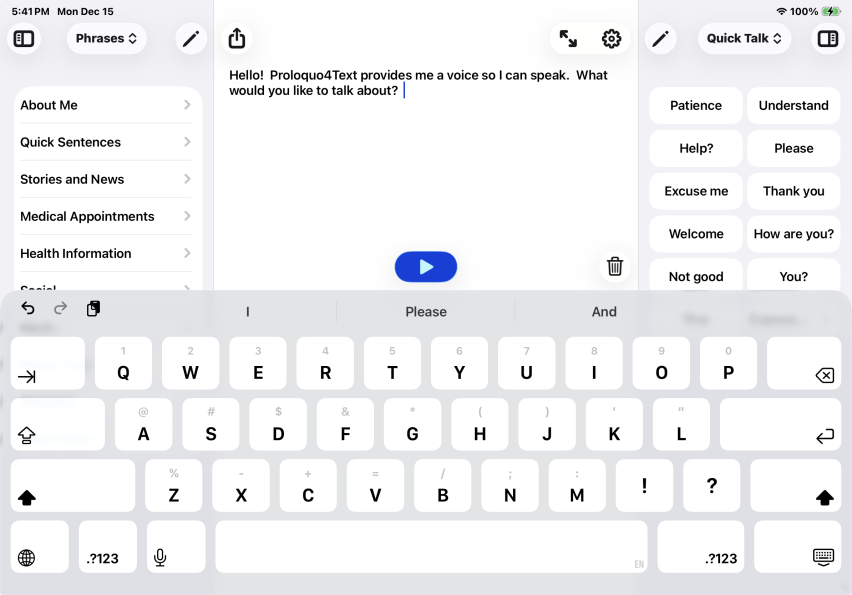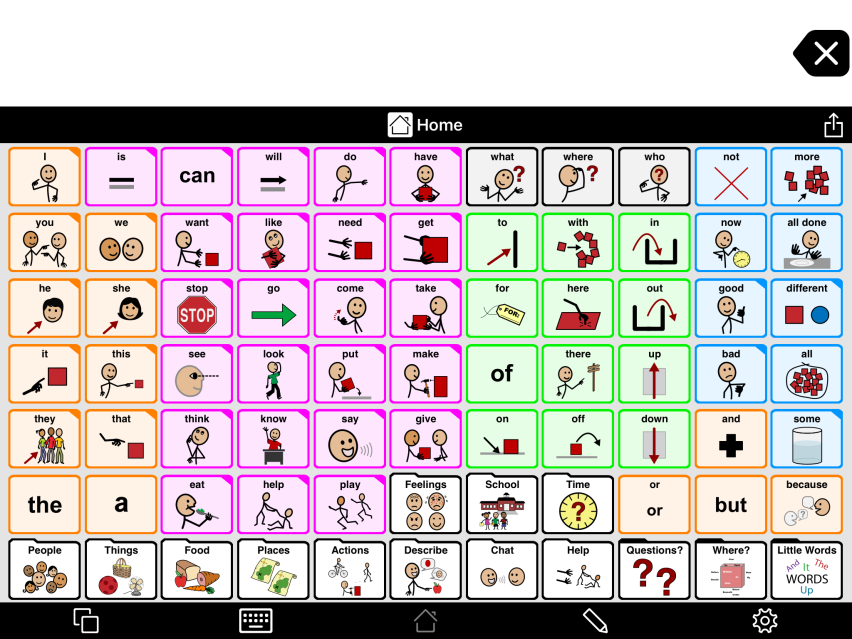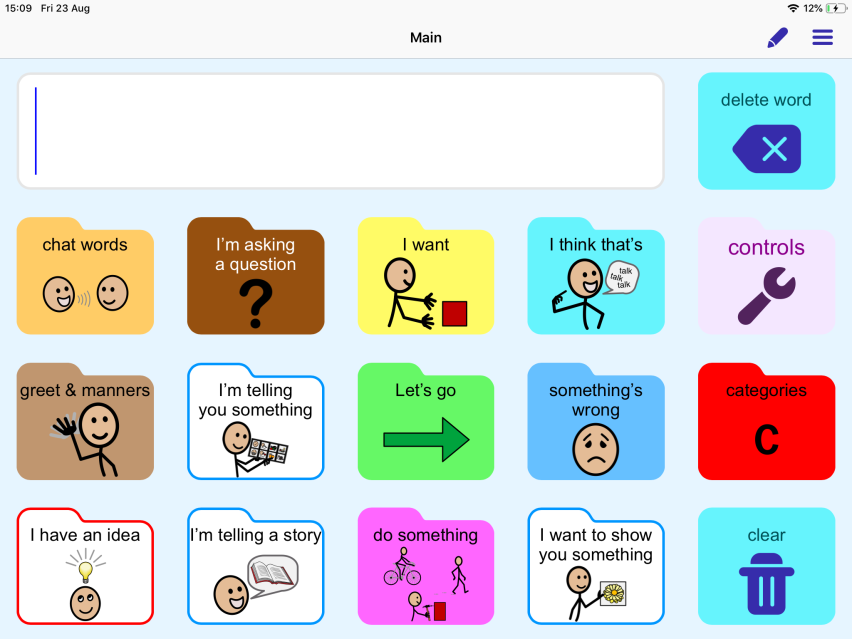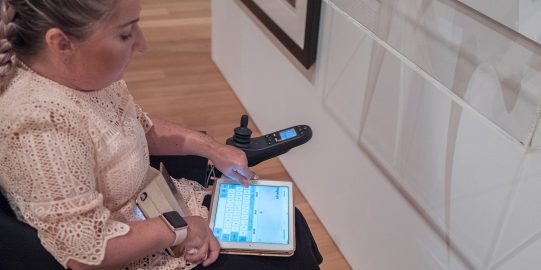Communication devices, systems, strategies and tools that replace or supplement natural speech are known as Augmentative and alternative communication (AAC). These tools support a person who has difficulties speaking.
How do we decide who needs AAC? When should AAC be started? How can we best determine if the person needs, or would benefit, from alternative tools and strategies to support communication?
Who uses AAC?
Anyone can use AAC. People who cannot talk for different reasons may benefit from using AAC. There are a wide range of reasons, disorders, and disabilities that can result in a person not being able to speak. They may have a developmental disability or acquired disorder that has affected his or her ability to talk. Some people experience deterioration of their speech due to a medical condition. Or they may have lost the ability to speak due to stress, anxiety, or even a medical emergency.
Someone can’t speak. When can they start using AAC?
Many people who cannot speak may benefit from some form of AAC to support communication. But when do we start? When is the right time?
First and most importantly, there are no age prerequisites to using AAC. You cannot be too young or too old to use AAC. Starting AAC can happen at any age. And once someone has started with AAC, they may not have to use their system forever or all the time.
AAC would be recommended in these cases:
- As speech is developing
- To support speech that is hard to understand
- When no speech has developed
- If speech is lost or is deteriorating
- When speech is temporarily not possible
- When speech is intermittent or unreliable
We can’t always tell whether a person needs AAC or not based on their diagnosis. A person with autism may or may not need AAC. A person who has had a stroke may or may not need AAC.
AAC even if you can talk
Just because a person can talk in some way, some of the time, it does not mean that they would not benefit from AAC. Providing an AAC system to a person with limited speech or unclear speech will give them more words and language. Then it is the possible for them communicate far more than they can with speech alone.
Do we need AAC? Complete this checklist
If you know someone who might need AAC, complete this checklist to help decide. Download the AAC Finders Checklist.
If you are considering AAC for yourself, may wish to complete this checklist to decide if you think you could benefit from AAC. Download the “Should I try AAC?".
AAC assessment and evaluation
If you have decided that you need AAC, there are many different AAC approaches and systems from which to choose. Many factors go into making the right choice: physical access, sensory needs, language and literacy skills, and support available in the environment, to mention just a few.
The choice of an AAC system would be made so much easier if there were a test that would tell us what to pick. However, many people who cannot speak may have no way to take tests or assessments. They might not be able to do a common test for speech, language or literacy skills. And even when testing is possible, the complex factors make it hard to determine a good “AAC match”.
Instead, it is best to use a process called “dynamic assessment”. We can observe:
- how the person currently communicates different messages in different environments, during different activities,
- their informal communication behaviours,
- their communication partners and how they support the person.
Then we start using one or more AAC systems or approaches that are possible matches. We observe how each system or approach works. This helps to come to a decision about which to recommend. The dynamic assessment works best if it is conducted with the help of a professional with experience in AAC.
Search some useful articles for specific checklist and tools for the assessment of communication for AAC.
No prerequisite skills
In your AAC assessment process, you may hear that certain “prerequisite skills” are needed before AAC can be started. "Prerequisite skills" came from a time in the 1980’s when American Speech and Hearing Association (ASHA) first recognized AAC as an area of practice. We have come a long way and research has changed how we think. There are no prerequisite skills needed for AAC. In fact, anyone who cannot speak to meet his or her communication needs can benefit from some form of AAC. People do not have to prove themselves before they can be offered AAC.
Get help teaching communication
Speech-Language Pathologists/Therapists, generally, should have received training in the area of AAC. But not all “Speechies” have had the same training or experience using AAC. They can do speech therapy to support AAC use. Similarly in schools and hospitals, other support staff (such as teachers, other therapists, nurses, or social workers) will have had different experience levels with people who use AAC. So much knowledge is gained when you work in the area of AAC. If you need support with AAC, always seek a professional who has worked in the field of AAC.
You can also go online. There are many many supportive communities, with experienced families and professionals, all offering advice and support.
Our Facebook communities are: AssistiveWare's Family members AAC community, AssistiveWare's Teachers and therapists AAC community, and simPODD Family members community.
What AAC do you need?
Would the potential AAC user prefer or benefit from an Unaided forms of AAC, such as gestures, facial expression or sign language?
Or would they benefit from an Aided form of AAC such as choice cards, symbol boards, or high-tech tools (eg. Speech generating devices, communication device, AAC app on an iPad, etc.)?
A potential AAC user can also use a text-based AAC system or a symbol-based AAC system.
If someone types to communicate, they can use a text-based AAC system, such as Proloquo4Text.







